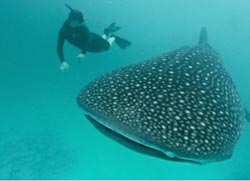Scientists using holiday snaps to identify whale sharks

www.whaleshark.org
Holidaymakers' photos could help scientists track the movements of giant endangered sharks living in the waters of the Indian Ocean. A new study, led by a researcher from Imperial College London, is the first to show that these publically sourced photographs are suitable for use in conservation work.
Tourists scuba diving and snorkelling in the Maldives frequently take underwater pictures of the spectacular and docile whale shark, often called the world’s largest fish. Conservationists have long hoped to use this photographic resource to help them trace the sharks’ life history, relationships and geographic distribution, although the value of these amateur snapshots has never been properly measured.
Tim Davies of Imperial’s Department of Life Sciences is the lead author on a study published in Wildlife Research, the first to examine how reliable photographs sourced from the public actually are. He and his team did this by comparing results using tourist images with results based on surveys by marine researchers specifically aiming to track the sharks.
In order for a shark to be clearly identified, any photograph must capture the distinctive pattern of spots located directly behind the gills. This unique marking serves as a ‘fingerprint’, which can then be scanned with a computer programme to tell the animals apart.
The study looked at hundreds of images taken by the public, of which many were downloaded from image-sharing websites such as Flickr and YouTube. Individual whale sharks could be successfully identified in 85 per cent of cases, surprisingly close to the 100 per cent identification possible in photographs taken by researchers.
Speaking about the results, Davies said: “Globally, this outcome provides strong support for the scientific use of photographs taken by tourists for whale shark monitoring. Hopefully, this will give whale shark research around the world confidence in using this source of free data. In the Maldives in particular, where whale shark tourism is well established and very useful for collecting data from throughout the archipelago, our results suggest that whale shark monitoring effort should be focused on collecting tourist photographs.”
Although they are widely thought to be rare, the conservation status of the whale shark has long remained uncertain. This study therefore allowed the team to measure the populations of whale sharks in the area, which they estimate have not declined in recent years. Davies added: “Hopefully, as more data come in from tourists over the years and from further across the archipelago, we will be able to build up our understanding of the Maldives population and monitor its status closely.”
Holidaymakers heading to the Maldives, as well as to other regions, can assist researchers in monitoring whale shark populations by uploading their shark photos to the ECOCEAN whale shark identification library website (www.whaleshark.org). For more information on Maldivian whale shark visit the Maldives Whale Shark Research Programme website (http://maldiveswhalesharkresearch.org).
Media Contact
All latest news from the category: Ecology, The Environment and Conservation
This complex theme deals primarily with interactions between organisms and the environmental factors that impact them, but to a greater extent between individual inanimate environmental factors.
innovations-report offers informative reports and articles on topics such as climate protection, landscape conservation, ecological systems, wildlife and nature parks and ecosystem efficiency and balance.
Newest articles

Combatting disruptive ‘noise’ in quantum communication
In a significant milestone for quantum communication technology, an experiment has demonstrated how networks can be leveraged to combat disruptive ‘noise’ in quantum communications. The international effort led by researchers…

Stretchable quantum dot display
Intrinsically stretchable quantum dot-based light-emitting diodes achieved record-breaking performance. A team of South Korean scientists led by Professor KIM Dae-Hyeong of the Center for Nanoparticle Research within the Institute for…

Internet can achieve quantum speed with light saved as sound
Researchers at the University of Copenhagen’s Niels Bohr Institute have developed a new way to create quantum memory: A small drum can store data sent with light in its sonic…





















